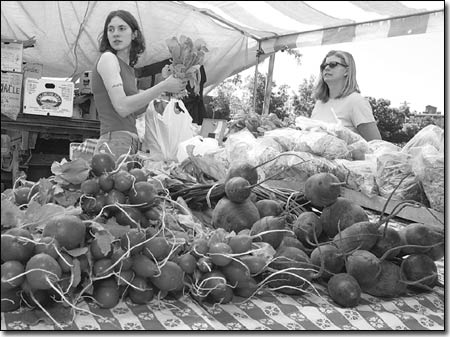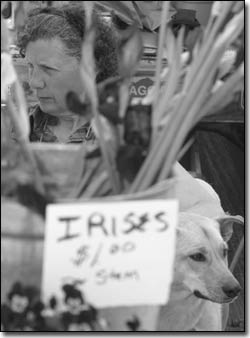|
Customers and farmers appreciating value of
local food
by Wil Sands
 |
| Linda James, of Stone Free Farms,
works amongst piles of radishes and beets as she helps a customer
at the weekly Durango Farmer's Market on Saturday morning.
Last week marked the first Farmer’s Market of the season./Photo
by Todd Newcomer. |
The white tents went up, the produce rolled in, the customers
arrived and when noon struck last Saturday, the Durango Farmer’s
Market boasted its biggest day in nine seasons. This first day’s
success was no fluke, but has been attributed to area residents
placing a greater value on locally grown foods and products. And
in coming years, there is hope that the residents of La Plata
County will continue to support and eventually rely largely on
local farms.
“This year already seems really, really good at the Farmer’s
Market,” said Sue Bruckner, executive director of the market.
“Our vendors said this year’s first market on Saturday
was better than any of last year’s.”
Greg Vlaming, CSU Cooperative Extension agent and a director
of the market, concurred, adding that the quality of the market
also has improved. In past years, vendors would frequently be
cleaned out early in the day. This year, local farmers and producers
came better prepared.
“Last year, we were selling out by 10 a.m.,” he said.
“The vendors have increased their capacity and this year
people were taking produce home. The market is really improving,
one farmer and one customer at a time.”
The Durango Farmer’s Market is the most obvious indicator
of the growth of locally harvested and produced foods. And for
numerous reasons, Vlaming and Bruckner and others find this growth
reassuring.
 |
| Joanie Trussel, of Evening Star Farm, stands
behind a vase of irises Saturday morning at the Farmer's Market./Photo
by Todd Newcomer. |
“If food has to be trucked in, there’s money down
the drain,” Vlaming said. “When food travels hundreds
of miles, it’s also time delayed and there are freshness
issues. When you buy local food, you put money back into the economy.
You’re also helping to maintain open space. A farmer who
is making it financially is going to be less apt to subdivide
his land.”
Bruckner added, “Even looking at animal rights issues,
when you buy locally you have a better idea how the animals are
being treated. There are numerous environmental issues tied to
transportation. There are also social justice issues where many
farms treat their employees poorly. With local operations, you’re
in the know.”
Jim Dyer is the president of the Colorado Organic Producers Association,
the part-owner of Dyers’ Wool and a Durango Farmer’s
Market mainstay. Dyer added that many people think they are doing
right and buying organic at the grocery store. However, in many
cases, they would be better off buying local produce that is not
certified organic.
“Organic food is one of the brightest spots in the whole
U.S. agricultural picture,” he said. “But you’ve
also got larger, corporate money in it now, and they may be following
the rules but they may not be aligned philosophically. Organic
also does not look at the distance the food has been transported.”
After putting together some figures on local food consumption,
Dyer discovered that La Plata County spends approximately $180
million on food and food related products every year. With this
in mind, he said that there is tremendous future opportunity for
local growers.
“Very conservatively, we’re looking at several million
dollars that are being spent on fruits and vegetables,”
Dyer said.
Like Vlaming, Dyer said that the growth of the local food industry
depends on two factors – supply and demand. “We’re
trying to get more producers,” he said. “On the other
hand, once you get more people interested in locally grown food,
you can start tapping that market.”
A long-term dream is for La Plata County to eventually subsist
almost entirely on locally grown produce and goods. While acknowledging
that this ideal is still way down the road, Bruckner noted, “I
think it’s attainable. I’m one person who is pretty
optimistic.” 4
Dyer agreed that the goal for La Plata County is total independence
from outside food. However, he said that it is definitely a long-term
one. “We want to strive for that goal,” Dyer said.
“But for now we’re just trying to get people to buy
as much local as possible and helping the community grow with
its needs.”
Illustrating why this goal will take time, Vlaming explained
that even meeting current demands can be difficult. In addition
to his other functions, he also owns and operates Foxtail Farm.
And though he sold out prior to the market last week, he said
it can be difficult to have an operation that is sustainable environmentally,
socially and economically.
“It’s difficult at times,” he said. “I
have a small, organic farm and it’s difficult to take care
of those three factors and come up with a crop people are interested
in.”
Dyer said that getting people to commit to local foods and eating
what is in season is another challenge. “I liken it to people
deciding to get rid of a portion of their lawn to save water,”
he said. “People have to decide, ‘Maybe I don’t
need strawberries every month of the year.’ But we do have
a good, enlightened set of consumers in La Plata County.”
Over the long term, Bruckner said she sees sustainable, local
agriculture coming from a variety of places. One is local growers.
Another is local people gardening and growing a portion of their
own food, an effort she is working to support with the Garden
Project of Southwest Colorado.
“In a separate project, we’re working to build a
sustainable food system through garden projects,” Bruckner
said. “When I think of sustainable agriculture, I especially
want to help disadvantaged people have the opportunity to grow
their own foods.”
She added, “I think sustainable agriculture is a combination
of things and part of that is people doing their own gardening.
It’s tough to farm on a large scale and tempting to go out
and just spray the chemicals. It’s a lot easier for people
to do it in the back yard, and some of our local, organic farmers
are doing a lot on just 1 or 2 acres.”
With a mind to large scale, Vlaming did relate the example of
many families that are resisting the temptation to go out and
spray. He said that there is a growing trend among existing agricultural
operations to experiment and convert to more organic practices.
“There are some people in the sector that are saying the
old way isn’t working and we need to try something different,”
he said.
Vlaming concluded, “As our agriculture population continues
to grow, hopefully the demand will grow with it. I’ve found
that there is a real desire for fresh, local produce. Now it’s
a question of getting the farmer and consumer together.”
In coming weeks, Dyer said that farmer and consumer will have
a little easier time of getting together. One of his groups, the
Southwest Marketing Network, was founded with the mission of expanding
markets for small-scale, alternative and minority farmers and
growers in the Southwest. To this end, the network has produced
the “Mesa Verde Country Guide to Local Sustainable Food
and Fiber.” The guide covers a “trading area”
inside a 90-mile radius around Mesa Verde National Park and is
expected to go to the printer in coming weeks and be available
for distribution by the end of June.
“We want to draw attention to the number of local farms,
what size they are and what their market is,” Dyer said.
“Right now, we’ve got about 30 producers listed, and
I’m sure it’s just the tip of the iceberg.”
|

